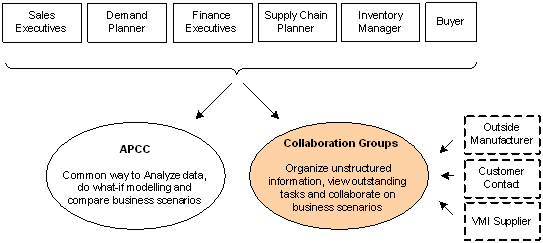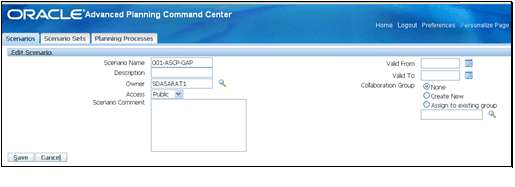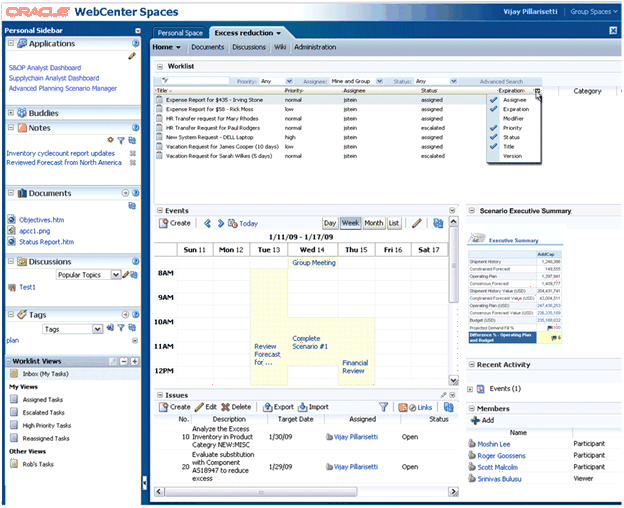Advanced Planning Command Center Overview
This chapter covers the following topics:
- Advanced Planning Command Center Overview
- Overview of Scenarios
- Overview of Web Services
- Overview of Dashboards
- Overview of Collaborative Workspaces
- Executive Summary Report as a Portlet
- Work List
- Data Security
Advanced Planning Command Center Overview
Oracle Advanced Planning Command Center unifies all the Advanced Planning applications such as Demand Management, Real-Time Sales and Operations Planning, Strategic Network Optimization, Advanced Supply Chain Planning, Distribution Requirements Planning, and Inventory Optimization. It provides a unified user interface and a single repository of all data. It is flexible, enabling the user to access data from external supply chain planning applications and make them available for reporting and analysis within a unified user interface based on Oracle Business Intelligence - Enterprise Edition (OBIEE).
Overview of Scenarios
Oracle Advanced Planning Command Center enables users to define multiple what-if planning scenarios that simulate different business parameters. Users can associate the scenarios to underlying Predefined Business Process Execution Language (BPEL) processes and automate the execution, orchestration, and monitoring of the scenarios. It provides extensive plan and scenario comparison capabilities, and facilitates the collaboration required for inter-organizational and interdisciplinary planning processes such as Sales and Operations Planning.
See Understanding Scenario Planning
Overview of Web Services
Oracle Advanced Planning Command Center provides access to an extensive list of Web services that decompose Oracle Advanced Planning capabilities into atomic functional pieces. BPEL processes leverage these Web services and they can be used to automate and orchestrate sales and operations planning and supply chain planning business flows.
See Web Services
Overview of Dashboards
Users can view plan outputs using predefined, role-based dashboards with seeded reports that expose a collection of more than 200 facts. These facts span the entire planning spectrum and can be analyzed across more than 20 dimensional hierarchies. These dashboards can be customized at the user level, which can also expose custom OBIEE reports. Predefined dashboards are provided to support the sales and operations planning and the supply-chain analysis business processes.
See Understanding the Supply Chain Analyst Dashboard and Using the Sales and Operations Planning Dashboard.
Overview of Collaborative Workspaces
APCC incorporates a collaboration platform for a variety of roles, such as demand planners, supply chain planners, inventory managers, that seamlessly integrates with existing APS applications. It gives planners with an easier way to record and share various key inputs, assumptions & decisions that affect their planning decisions with other members of the organization.
Collaborative workspaces provide:
-
An ability to quickly form ad-hoc, virtual groups for specific planning tasks.
-
A way to share structured and unstructured content that relates to that group.
-
A single, flexible portal-like user interface that brings together specific components of various planning applications and the collaboration tools that are needed for the group to accomplish that task.
The collaboration is based around a business scenario, that is, a planning scenario, as defined in Advanced Planning Command Center (APCC) and would enable you to optionally leverage a set of collaboration capabilities around the scenario.
An overview of the collaboration is shown below:

The design enhances the collaboration to create personalized work lists, store documents, group event calendar, to-dos, notes etc. that can be assigned to users, while re-using the concepts of tasks from APCC.
Collaboration Group
During creation of a planning scenario, you have collaboration options with which you can create a collaboration group and also assign application users to this group.

From the Create Scenario window, you can:
-
Create a new collaboration group by choosing the Create New option. The name automatically defaults to the Scenario name, but you can change it.
-
Assign your scenario to an existing collaboration group by choosing the Assign to existing group option. You can choose a value from a list of values of valid collaboration groups.
-
Choose not have any collaboration group created for this scenario by choosing the None option. If the scenario was previously associated with a collaboration group, then you can remove the link to that group.
Note: If you want to add members, you must choose the Create New option.
Collaboration Group Home Page
To access the collaboration home page, select Collaboration Home from the Advanced Planning Scenario Manager responsibility.
Group Space
Group Spaces that are created from APCC are containers for all the collaboration activity that occurs within each group. It is directly tied one-to-one to a scenario and shares all the attributes of that scenario. The name of the scenario becomes the name of the group; the owner of the scenario becomes the moderator of the group.
New group spaces can be created within WebCenter. They are managed by, but are not tied in to, the APCC scenarios. For example, if you delete a group space within WebCenter, it does not delete or update the APCC scenarios.
Group Space Template
The seeded default template for the home page includes the following content:
| Collaboration Tools | Work list, Group Calendar, Documents, Discussions, Tags, Issues & Notes |
| Product Content | Executive Summary Report from S&OP Dashboard for that Scenario |
You can customize the content to suit your business needs. Following is an example of a custom group space with additional content.
Below is an example of a custom group space with additional content.

Navigation Rules To and From the Collaboration Home Page
When you access the APCC dashboards or the APCC scenario manager application, you go directly to the respective application.
The navigation to and from the collaboration home page follows these basic rules:
| From | To | Context |
| Advanced Planning Scenario Manager | Collaboration Home | None |
| Collaboration Home (left navigator pane) | S&OP dashboard, SCA dashboard, Advanced Planning Scenario Manager and other applications | None |
| Collaboration Home (group space application links) | S&OP dashboard, Advanced Planning Scenario Manager and other applications | Scenario context. (If there are multiple scenarios, default the first name in alphabetical order.) |
| Collaboration Home (group space application links) | SCA dashboard | Plan context (If there are multiple plans, default the first name in alphabetical order.) |
Executive Summary Report as a Portlet
Within the S&OP dashboard, the Executive Summary Report is enabled as a portlet. It uses the current group scenario as the input and renders a single scenario view. All the drill-downs from this report to the S&OP dashboard and answers pages in the same browser window, but still keeps the left hand side Navigator of WebCenter intact.
Work List
The work list that is displayed in the Collaboration Group Home page is an amalgamation of all the tasks that flow from different sources for that individual user. This is not necessarily related to the scenario to which this Group corresponds. This work list portlet looks at the BPEL repository as the single source of truth for all tasks. The various sources from where these tasks come are all System tasks originated from APCC Planning Scenarios / BPEL Processes.
The table below shows the relationship between the work list column and the meaning of the APCC attribute:
| Work List Column | APCC Attribute Meaning |
| Title | BPEL Process Name created in Scenario Manager. |
| Status | Status: Possible values are: Assigned, Deleted, or Suspended. |
| Identifier | Plan Name |
| Category | BPEL activity status category, such as In progress, Not started, Error, or Completed." |
| Creator | Created by |
| Created | Date Created on |
Data Security
For all the portlets that are available in a group space (including the Executive Summary report), only the members have access. The reports from APCC are not available outside the context of a Collaboration group.